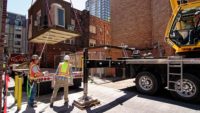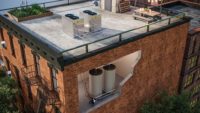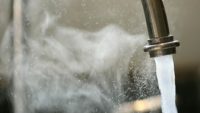In the ever-evolving landscape of sustainable technologies, heat pumps have emerged as champions of energy efficiency. These versatile systems, traditionally known for their prowess in space heating or cooling, have taken a giant leap forward by integrating water heating into their repertoire.
Traditionally, water heating has been a separate task, often relying on additional equipment such as gas boilers and tank or tankless style water heaters. However, by combining water heating with space heating through heat pumps, a synergy is achieved that maximizes efficiency. This dual functionality is particularly relevant given the constant demand for hot water in residential, commercial and industrial settings.
Harnessing efficiency
According to John Siegenthaler, P.E., PM Engineer columnist, any system that can keep heat sources running at optimal conditions will reduce energy input.
“Multiple boiler systems in commercial buildings that supply both space heating and domestic hot water are common,” he explains. “However, with transition to heat pump technology, it’s more likely to see purpose-built heating pumps, e.g., heat pumps designed specifically for either space heating and cooling, or for domestic water heating. Both types of heat pumps are likely to be in the same overall system but as two separate subsystems rather than a combined single unit. That said — there are some companies offering heat recovery
“In the case of heat pumps supplying both loads the space heating and cooling loads are estimated independently of the domestic hot water loads, and specific equipment selected for each load. With boilers that state of the art is a multiple boiler system that can supply heat to either space heating or domestic water heating. In this case, the building would use some type of chiller system for cooling.”
Siegenthaler notes that with sufficient funding, design engineers can get more creative with concepts such as heat recovery from outgoing ventilation air and use that heat for either space heating or domestic water heating.
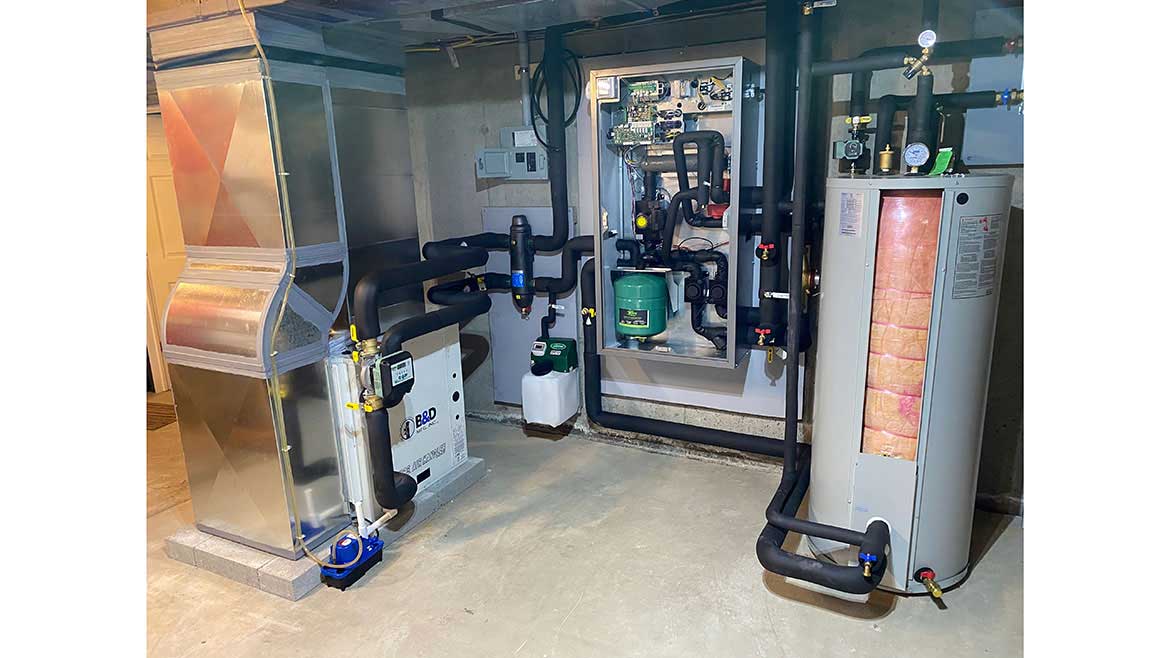
Trethewey notes that engineers should pay close attention to local utility rates. Depending on where your client is located, electricity costs can vary widely.
“Heat recovery chillers can also be used to use heat that would otherwise be rejected outside for either DHW or pool heating,” he says. “When budgets are tight, the designer doesn’t necessarily have the flexibility and may have to use equipment that just meets baseline standards and codes. It also depends on the expectations of the building owner and their architects. What ‘statement’ do they expect the building to make regarding energy use or efficiency? This is a big driver. For example, a college may want a new building that is net zero, with no fossil fuels, a solar PV system that provides all its electricity and built with materials that are all considered sustainable. They are using the building to convey a statement. An auto service garage might care little about those factors and instead want to heat the building with a waste-oil boiler to use the waste oil they collect.”
Ross Trethewey, P.E., founder and lead engineer of Needham, Massachusetts-based TE2 Engineering and a 2023 PM Engineer Next Gen All Star, notes that air-to-water heat pump technology is a big move toward electrication and decarbonization for buildings.
“We haven't had the ability to do heating, hot water and cooling from a single box outside before,” he explains. “That hasn't been part of the VRF strategy or the air-to-air heat pump strategy. Air-to-water heat pumps obviously open up that ability. Now, we can do radiant floor heating, domestic hot water heating and even cooling with chilled water that we couldn't do before. We're excited about the technology and we're starting to deploy it. We started a couple years ago designing systems that use that air-to-water technology. Mostly residential, but also some commercial as well.”
In retrofit strategies, Trethewey says the first low-hanging fruit his frim tackles is from a building envelope perspective. “Air leakage can represent 50% of the heat loss in the building. The best thing we can do with the budget that’s given is to get the building envelope as tight as and as insulated as possible. Once we've done that, we look at the strategies to give us that redundancy that we're looking for. If it's a house with a hot water baseboard that's designed for 180°, we might do an air-to-water heat pump strategy for that and back it up with the boiler. We just have smart controls that bring that boiler on only when needed. We let the air-to-water heat pump carry 80% or 90% of the heating season on its back.
“The second thing that’s very important is the heat pump really flourishes when it has runtime and it has low delivered water temperatures,” he adds. “So if I take an air-to-water heat pump and I design that system to run it a 100° to heat my building with underfloor radiant floor heating systems — it’s going to flourish with the COP of 4, it's going to be fabulous. The system's going to be purring along. It's going to creating heat very effectively with electricity. If I take that same heat pump and design it for a baseboard system that's designed for 130° or 140° water, it’s going to sacrifice COP big time. It might be 2.5, it might be 3. You might take a 40% hit in your efficiency with increasing your water temperature by 20%. So the delivered water temperature or the design water temperature is going to have big effect on the efficiency of the system. And most of these systems need buffer tanks to get the run times. You don’t want this thing to short cycle. That will kill your efficiency.”
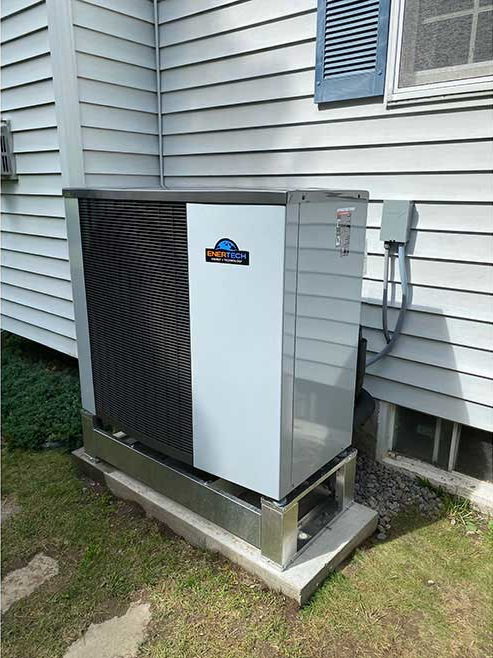
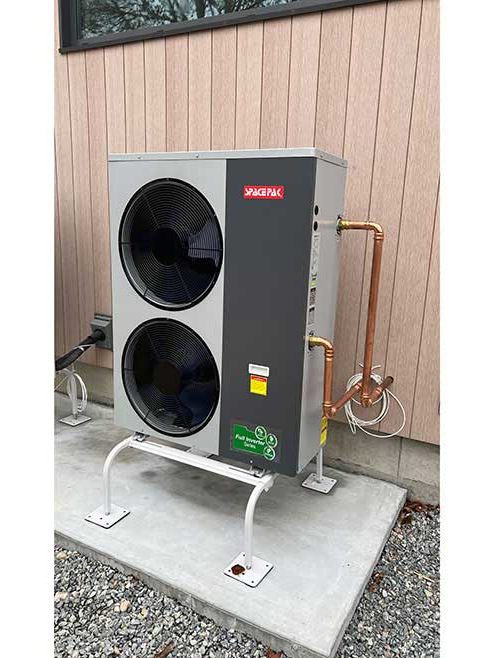
Trethewey's firm, TE2 Engineering, started designing systems using air-to-water heat pump technology a few years ago. Most of the systems have been residential, but the firm has done some commercial projects as well.
Advantages vs. disadvantages
There are many advantages to heat pump systems, though they depend on the loads of the building, Siegenthaler explains.
“For example, a hotel would be have loads that are very different from a retail building,” he says. “Designers should look for ways to move ‘unwanted’ heat from where it’s not needed to a loads that could use it. Such as recovering heat from outgoing ventilation air or even water leaving the building for a sewer, and using that heat where it’s needed — space heating, pool heating, domestic water heating, even snow-melting are all possibilities.”
It also depends on what type of system you’re comparing it to, Trethewey adds.
“The advantages for comparing it to geothermal, for example, is the up front cost, of course. There’s no drilling required,” he says. “If you compare it to VRF, we’re now using hydronics in the building — as John (Siegenthaler) always says, it’s the glue that makes all these systems come together. Now we can have solar, heat pumps, boilers — whatever we need to provide that final efficiency for that homeowner or building owner. VRF are all refrigerant DX-based systems. And we really don’t know what the future of refrigerants is going to be. They’ve already phased out R-22, but they’re already talking about phasing out R-410A maybe as soon as 2025. So who knows what will happen? But if you’ve got miles and miles of refrigerant piping in buildings, what’s going to happen when R-410A gets phased out when the system is designed for R-410A? You better have a replacement in mind to make that swap happen.
“We don’t have to worry about that with hydronics,” Trethewey continues. “The piping is water piping. It goes in one time. You can design systems with 100-year warranties on the piping side and off you go.”
The disadvantage of air-to-water heat pumps, is they cannot heat and cool at the same time, Trethewey points out. “The unit, generally speaking, can only heat or only cool. They can’t do both.”
Another disadvantage is they can only deliver about 130° water, he adds.
“In a retrofit building that’s designed with boilers at 180° water on design day, we can’t often meet the entire load with an air-to-water heat pump strategy,” he explains. “A lot of times, we’re going duel fuel in that system. So the air-to-water heat pump does the majority of the heating of the building¬ — maybe 90% of the heating, but 10% of heating is still done by gas, oil, propane or whatever the fossil fuel component may be to provide supplemental heating.”
Trethewey often designs systems with a fossil fuel source built in anyways to provide redundancy to the building or homeowner.
Additionally, Siegenthaler’s January column touches on how natural gas boilers can complement electric-source heat pumps by providing advantages like supplemental heating on very cold days, backup heating when the heat pump is down and resiliency to keep the system running without utility power to name just a few. Click here to read the column.
Location, location, location
There are many considerations when determining whether air-to-water heat pump technology would be a good fit for an application, but one of the largest deciding factors is climate zone, Trethewey explains.
“Where is the project? Are we in Maine? Are we in Boston? Or, are we in Florida?,” he says. “There are different solutions and different concerns depending on the climate zone. Once we know where the project is, and whether it’s new construction or retrofit, that’s going to determine a certain path. If we’re in a warmer climate, of course, we’re not going to care as much about heating or be concerned with frozen pipes like we are in New England. We’ll be focusing on cooling load, so it’s much easier to design for warmer climate areas.
“But in the colder climates, if it’s a retrofit strategy, we want to know what the existing systems are. Heat pumps work low and slow, and work with lower temperatures, which is why they’re more efficient. But, at the same time, they don’t work as fast and they can’t generate as much heat as a gas furnace or boiler. The ones you want to use are inverter driven, vapor injection rated for cold climates. The system also has to be set up for defrost. It will go into defrost at some time during the wintertime when the conditions are right, and that's something that, when it happens, you won't get any heating. That's another reason why you need a buffer tank.”
Another important consideration is the local utility rates. Depending on where your client is located, electricity costs can vary widely.
“What you pay for electricity compared to what you pay for gas, propone or oil differs dramatically as you move across the country,” Trethewey explains. “That is something that's always got to be in people's minds. Otherwise, you’ll hear situations where someone wants to electrify and do what’s right for the climate. So they take out a natural gas boiler and put in an air-to-water or any heat pump system for that matter, and their bill goes up from what it was previously. If you’re in an area with high electric rates and a really low natural gas rate, clients need to be understanding that even if you’re putting in a more efficient system, that doesn’t always mean lower operating costs. Efficiency and operating costs are different. They're not aligned in all cases. Many cases they are, but not always.”
Trethewey notes it pains him to hear stories of people who put in heat pumps and their utility bills double
“I want to make sure that people are understanding, I love heat pumps,” he says. “They are the best. They're the future. They're the most efficient, but if your rate per therm is very cheap, it may actually cost you more to operate the heat pump.”
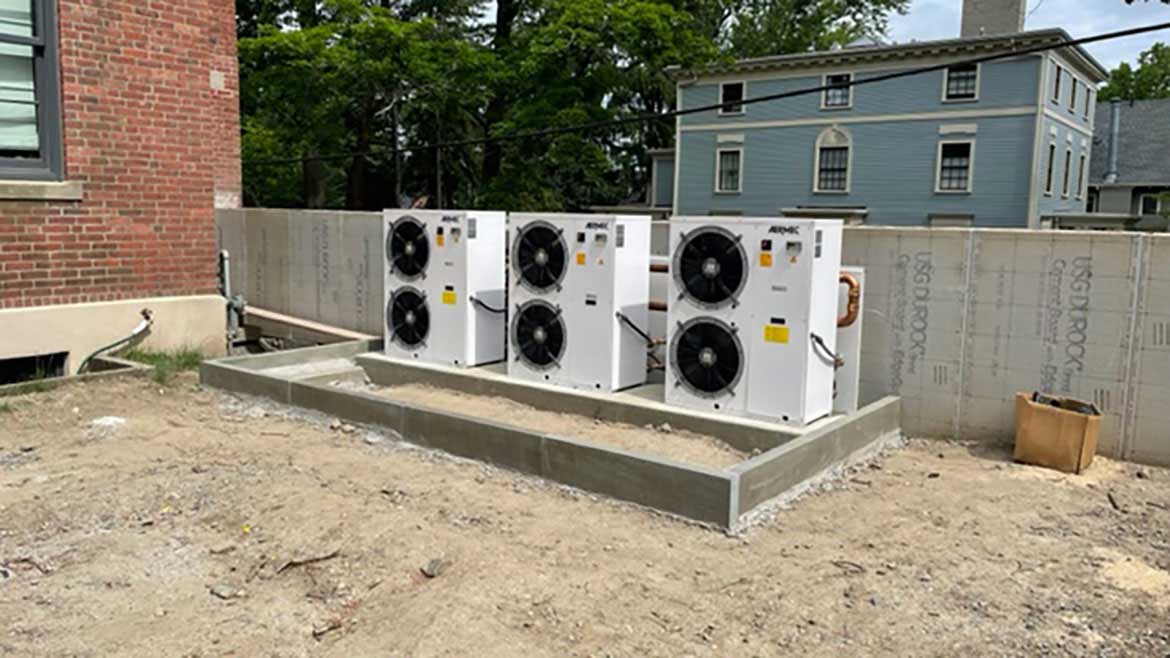
Heat pump systems can especially help meet decarbonization goals when adding renewable energy sources.
Incorporating renewable energy
Heat pump systems can especially help meet decarbonization goals when adding renewable energy sources. Air-source and geothermal heat pump technology are great examples of this, Siegnethaler notes. “Some buildings also include solar photovoltaic (PV) arrays to cover some of the electrical load of the HVAC and DHW systems. For buildings with oil-fired boilers, there is an emerging market for renewable diesel and bio diesel, both of which can be used in existing oil-fired boilers with little if any modifications. Such fuels could be what saves the existing fuel oil industry as electrification mandates essentially aim to eliminate fossil-fuels.”
It really comes down to what the building owner wants to accomplish, such as LEED Platinum designation, etc., Siegenthaler adds.
“Cost is always a factor, and ROI is typically a evaluated,” he says. “Different building projects can have very different goals in mind. It’s also important to consider the resiliency of the mechanical systems, for example — how would they survive a three-day power outage? Another factor is available servicing for the system. The use of more ‘exotic’ or proprietary hardware may drastically limit who can service the system, the cost of such servicing or how quickly that service would be available.”
The most straightforward way to incorporate renewables is solar PV, Trethewey states.
“Solar PV generates electricity, which is then used in the house or building,” he says. “The air-to-water heat pumps run on electricity, so they can be set up to offset each other. So they are very synergistic with each other. The costs for solar PV have come down so dramatically, that it’s like the low hanging fruit that is almost part of every project now that has electrification.”
Looking ahead
According to Siegenthaler, air-to-water heat pump technology are definitely the future for space and hot water heating. “Other technologies include heat recovery ventilation systems. Systems that separate the sensible and latent portion of cooling loads such as DOAS (direct outside air systems), chilled beams and radiant cooling. Thermal storage systems that coordinate with time-of-use utility rates. And district heating and cooling with thermal metering.
“Hydronics technology will continue to be ‘rediscovered’ by younger designers as a superior and very adaptable way to convey thermal energy in a wide variety of commercial buildings,” Siegenthaler adds. “It probably won’t replace the ‘boiler plate’ practice of dropping a few rooftop units on low rise commercial buildings (think dollar stores, McDonalds, strip malls, etc., where rooftops are easy to spec, lower cost, and provide marginal efficiency and comfort), but hydronics does provide a very flexible framework for more creative HVAC and domestic water heating solutions.”
Siegenthaler stresses that he advocates a “pragmatic approach that considers not only the heating cooling source equipment, but also the efficiency of the distribution system, and the comfort it provides.” Such an approach also considers serviceability and reliability.
“In my opinion, several state governments as well as the current federal government are fixated on complete and rapid elimination of fossil fuels without sufficient due diligence regarding the implications of such expedited shifts in the energy market,” he says. “I’ve had opportunity to interact with several people involved in setting government energy policy — mostly in New York. They are intelligent and well meaning, but the questions they are asking and some of the draft documents they are producing show a less than complete understanding of what’s possible when rational electrification is combined with strategic use of existing fossil fuels. For example, using a fossil fuel boiler to carry load when electrical demand on the utility is peaking, or when the building needs to be heated by an emergency generator are both very plausible. However, both of these are impossible when mandates require removal of all fossil fuel equipment as a requirement for incentives. Don’t throw the baby out with the bath water.”


